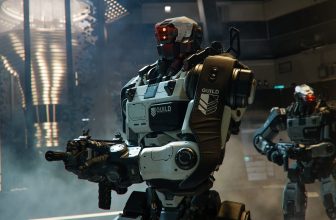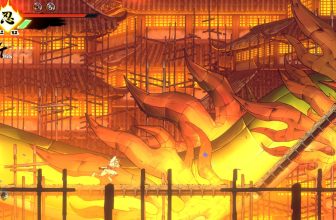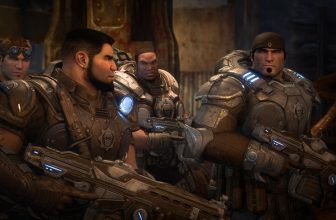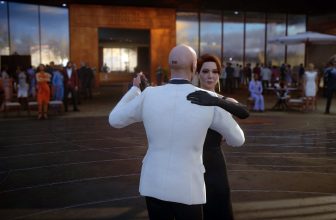
Solid Shooting In A Story That Falls Short
Everyone needs something from you in The Outer Worlds 2. From military leaders to bartenders, oligarchs to battlefield medics, the population of its science fiction world seems stuck in limbo without your character to guide them. The universe is vast, the game suggests, and entirely inert when outside of your view.
Though it’s a sequel to 2019 predecessor The Outer Worlds, Obsidian Entertainment’s follow-up doesn’t assume or require any real familiarity with what came before its story begins. It starts off by tossing you into its setting, a far-flung future where a now-spacefaring humanity has spread across multiple planets; introduces you to your character’s role as the Commander, an agent of a blandly heroic space cop organization called the Earth Directorate; and swiftly plops you into a high-stakes covert mission to save a galaxy-spanning colony from looming obliteration.
Heir to the tradition of not just The Outer Worlds, but also first-person action RPGs like Obsidian’s own Fallout: New Vegas, The Outer Worlds 2 presents the Commander as a blank slate for the player to mold to her preference. This extends from physical customization options and a set of loosely sketched character backgrounds—a professor or ex-convict, for instance—to a variety of personal attributes and attending skills. These run the usual gamut of role-playing traits, like how well the Commander can sneak around enemies, hack computers, pick locks, or convince others to adopt their point of view through conversation.

Once out in the world of the game, these skills have a large impact on how The Outer Worlds 2 plays out. The prologue sees you investigating a connection between humanity’s “skip drive” space travel technology and the appearance of roiling, reality-distorting “rifts.” This involves infiltrating a space station, either by crouch-walking through vents, manipulating machinery and avoiding the attention of enemy patrols, or simply shooting through the opposition and sweet-talking guards when the opportunity presents itself. Either way, the mission inevitably descends into violent chaos—big explosions, side characters bloody in the wreckage, some mild intrigue. The plot picks up nearly a decade later, with the Commander waking from suspended animation after drifting through space following the disaster, now finding themselves with a scarred survivor of the failed assignment and a talking robot as companions, and the thin but serviceable motivation of setting out into the galaxy to figure out exactly what went wrong with their mission as the catalyst for the two dozen or so hours that follow.
None of this is particularly exciting, despite the pyrotechnics and lingering plot questions of it all. There’s an immediate sense, as you venture onto the surface of the first sprawling planet of the many that will be explored throughout The Outer Worlds 2, that you’ve seen most of what the game has to offer in its prologue alone. In a way, this is true. The set-up is familiar video game sci-fi; warring factions of hardened, real-life-adjacent ideologues and high-concept cosmic mysteries introduced before letting the player loose to poke around a vast world at her leisure.
For anyone who’s played the modern Fallout or The Elder Scrolls games, let alone Obsidian’s own The Outer Worlds and this year’s Avowed, the shape of what’s to come is all too apparent from the outset. You will run around sprawling natural and urban landscapes, crafting and collecting items, chatting with strangers to take on quests, finding companions to accompany you on your journey, and massacring countless enemies along the way. There are experience points to gain, characters milling around towns with a few lines of dialog to hear, and an overarching plot to progress that often feels beside the point during hours of idle exploration.
The texture of this familiar terrain can go a long way toward making a game work or not. Fortunately, the act of moving and murdering through the game’s world is enjoyable enough to distract from its larger failings for a while. The Outer Worlds 2 is focused on sprinting (and, once a specific item is acquired, double jumping) across a series of planets; gunning down enemies that include human soldiers, whirring drones, hulking battle robots, and an assortment of alien animals; and reading notes while picking through the drawers, corpses, and countertops of enemy bases. The fighting is best at range, with a large arsenal of guns to pick from that span the typical video game line-up of pistols, shotguns, submachine guns, and rifles through to more bizarre variations that might, in one case, throw bolts of lightning or, in another, globs of putrid green goop. The smack of bullets against enemies and the bursts of numbers that come flying from them as their health bar depletes is brain-tickling enough to make doing so over and over again less of a chore than it might otherwise be.
This is all helped along by the fact that The Outer Worlds 2 has a strong, if too familiar, look. Each planet contains vistas resembling the covers of pulp sci-fi paperbacks. Whether a forested planet, where the broad red leaves of trees contrast with green mountains and purple flowers, or a broken-down art deco train station overlooking rocky canyons, with spears of rocky mineral deposits jutting from its ground, the vibrant, sometimes garish colors of the game’s environments are a consistent highlight. This extends through to the setting’s architecture, too. The military and research installations that dot each of the planets feature rounded plastic exteriors and chunky, postwar computer terminals, with wooden crank handles attached to their sides as controls. The retrofuturist look of glowing hologram advertisements and 20th century propaganda posters may be as kitsch as the game’s soundtrack—a selection of mid-century jazz that would fit as easily in a Fallout game as it does here—but it all works to enliven the otherwise dull proceedings.

In The Outer Worlds 2, a set of ideologically rigid factions vie for control of the setting. These include the ruling Protectorate, a pseudo-communist authoritarian monarchy with a penchant for high technology, as well as Auntie’s Choice, a hyper-capitalist corporation created from a merger of the first game’s Auntie Cleo and Spacer’s Choice companies. There are also the Commander’s Earth Directorate, and a cultish force of utopian math-worshipping scientists called The Order of the Ascendant. Most of the game’s major choices involve sympathizing with or opposing these factions, helping them achieve their goals, thwarting them, or finding compromises that keep everyone as happy as possible—even working together in uneasy alliance during some sequences. At its best, the thorny conversational decisions featured in this style of design can resemble a series of philosophical puzzles that make the player consider their own outlook on life through difficult moral dilemmas. Here, though, the major factions are presented with such cartoonish simplicity that it’s hard to feel much of anything for them.
The Protectorate are depicted as hapless and brainwashed, their love of robots and unthinking devotion to their leadership stifling their ability to think creatively about how to achieve the egalitarian society they desire. The capitalists, on the other hand, are so in love with buying and selling that they willfully turn a blind eye to the human suffering that their devotion to unregulated commerce entails. Every faction is totally devoted to their ideology, typically unable to recognize blind spots in their thinking until the Commander, with a high enough Speech skill, shows them the gaps in their outlook.
All of this is colored with a satiric tone that papers over the thin characterization of these factions and their members. The Outer Worlds 2’s limp sense of humor prevents its story from becoming oppressively grim, but it also keeps its portrayals of corporate servitude and the terror of authoritarian rule at arm’s length, maintaining a hedged distance from its subject matter that replaces emotional honesty—and dramatic heft—with an ironic wink at nearly every turn. (A Tweedledee, Tweedledum pair of Auntie’s Choice executives, for instance, raise the issue of a worker’s strike at one of their factories with outsized disbelief at the concept of their laborers’ ingratitude for their crushing jobs.)

This approach makes the line-up of companion characters who join up with the Commander throughout the story a bland bunch, too. Each of them is presented as a mascot for their faction, whether that be an Auntie’s Choice soldier who’s been the subject of macabre scientific experiments, a Protectorate fanatic struggling with his role as a violent agent of the state, or a cultist with a serial-killer-like thirst for blood. Each of these characters’ story arcs supplement your understanding of their respective factions through a personalized representation of that faction’s ideology. But these plotlines are largely flat, terminating with abrupt moments of “growth” in which the companion realizes the need to broaden their viewpoint. Worse are those that hinge on convincing companions to spare a character they’re set on killing, usually in an act of revenge, which is hard to care much about when the worth of one life is measured against the dozens of unnamed enemies that have been murdered en route to the scene in question.
While common to video games, this blinkered sort of moral questioning is hardly convincing—and it points toward The Outer Worlds 2’s generally compromised approach to interactive drama. There is, basically, no sense of conviction to any topic the game addresses. The Outer Worlds 2 motions broadly at the concerns of our actual world, through abstracted versions of real history and modern society, and condemns what it finds there through aloof jokes about the wilful blindness to human misery that authoritarian rule and a consumerist culture require.

-
Back-of-the-box quote:
“Shoot for the moon. Even if you miss, your SMG will ricochet among the stars.”
-
Developer:
Obsidian Entertainment
-
Type of game:
Action role-playing game
-
Liked
Memorable sci-fi landscapes and architecture; punchy movement and shooting.
-
Disliked:
Drab, predictable plot and one-dimensional characters.
-
Platforms:
PC (Played on), Xbox Series X/S, PS5.
-
Release date:
October 29, 2025
-
Played:
About 26 hours to complete the main story, all available companion missions, and a lot of side missions.
There’s a bitter irony to its attempt to point out the evils to which corporate interests lead that’s undercut not just by the sense of remove its story maintains, but by the real-world context of Obsidian Entertainment’s current position as a Microsoft-owned studio. A deep-pocketed patron might be necessary to fund games as lavishly constructed as The Outer Worlds 2. The fact that its money comes from a real-world corporation currently facilitating genocide has a way of dulling the bite of its intended anti-corporate satire, though. This is a problem inherent to big-budget art and entertainment, where money often comes from corporations whose actions may—and, in this case, do—damage the intent of the work made in association with them. But the result is impossible to ignore.
Together with the indifferent, overly simplistic portrayal of its subject matter, the context of the game’s production means that the many choices you’re asked to make throughout The Outer Worlds 2 ring hollow. By the time the credits roll, preceded by a slideshow of images showing how your Commander’s decisions impacted the future of the game’s world, there’s a deflating sense that none of the time spent inhabiting its setting has mattered. Its characters might have changed their point of view, and the outcome of the final battle might have played out slightly differently based on your choices, but the cast is so artificial that it’s easy to imagine them all quietly shuffling back to their original marks, ready to start the whole story over again from the beginning when another player boots up the game. The Outer Worlds 2 promises flexibility in storytelling, but when that flexibility comes from interacting with one-dimensional characters who inhabit such an unconvincing world, there isn’t much of a point to it.






